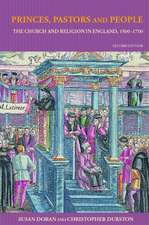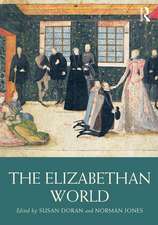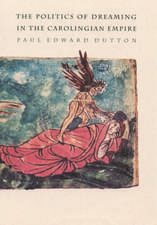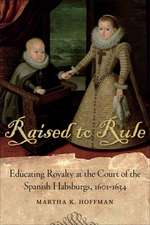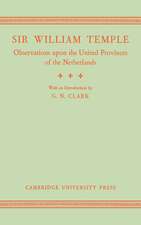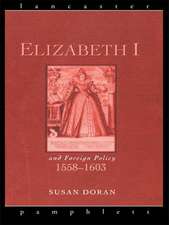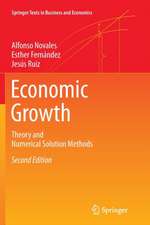The Image of Elizabeth I in Early Modern Spain: New Hispanisms
Editat de Eduardo Olid Guerrero, Esther Fernández Cuvânt înainte de Susan Doranen Limba Engleză Hardback – 28 feb 2019
Queen Elizabeth I was an iconic figure in England during her reign, with many contemporary English portraits and literary works extolling her virtue and political acumen. In Spain, however, her image was markedly different. While few Spanish fictional or historical writings focus primarily on Elizabeth, numerous works either allude to her or incorporate her as a character.
The Image of Elizabeth I in Early Modern Spain explores the fictionalized, historical, and visual representations of Elizabeth I and their impact on the Spanish collective imagination. Drawing on works by Miguel de Cervantes, Lope de Vega, Pedro de Ribadeneira, Luis de Góngora, Cristóbal de Virués, Antonio Coello, and Calderón de la Barca, among others, the contributors to this volume limn contradictory assessments of Elizabeth’s physical appearance, private life, personality, and reign. In doing so they articulate the various and sometimes conflicting ways in which the Tudor monarch became both the primary figure in English propaganda efforts against Spain and a central part of the Spanish political agenda.
This edited volume revives and questions the image of Elizabeth I in early modern Spain as a means of exploring how the queen’s persona, as mediated by its Spanish reception, has shaped the ways in which we understand Anglo-Spanish relations during a critical era for both kingdoms.
The Image of Elizabeth I in Early Modern Spain explores the fictionalized, historical, and visual representations of Elizabeth I and their impact on the Spanish collective imagination. Drawing on works by Miguel de Cervantes, Lope de Vega, Pedro de Ribadeneira, Luis de Góngora, Cristóbal de Virués, Antonio Coello, and Calderón de la Barca, among others, the contributors to this volume limn contradictory assessments of Elizabeth’s physical appearance, private life, personality, and reign. In doing so they articulate the various and sometimes conflicting ways in which the Tudor monarch became both the primary figure in English propaganda efforts against Spain and a central part of the Spanish political agenda.
This edited volume revives and questions the image of Elizabeth I in early modern Spain as a means of exploring how the queen’s persona, as mediated by its Spanish reception, has shaped the ways in which we understand Anglo-Spanish relations during a critical era for both kingdoms.
Preț: 469.83 lei
Nou
Puncte Express: 705
Preț estimativ în valută:
89.90€ • 96.14$ • 74.96£
89.90€ • 96.14$ • 74.96£
Carte tipărită la comandă
Livrare economică 17 aprilie-01 mai
Preluare comenzi: 021 569.72.76
Specificații
ISBN-13: 9781496208446
ISBN-10: 1496208447
Pagini: 420
Ilustrații: 29 illustrations, index
Dimensiuni: 152 x 229 x 31 mm
Greutate: 0.78 kg
Editura: Nebraska
Colecția University of Nebraska Press
Seria New Hispanisms
Locul publicării:United States
ISBN-10: 1496208447
Pagini: 420
Ilustrații: 29 illustrations, index
Dimensiuni: 152 x 229 x 31 mm
Greutate: 0.78 kg
Editura: Nebraska
Colecția University of Nebraska Press
Seria New Hispanisms
Locul publicării:United States
Notă biografică
Eduardo Olid Guerrero is an associate professor of Spanish at Muhlenberg College. Esther Fernández is an assistant professor in the Department of Spanish, Portuguese, and Latin American Studies at Rice University. Susan Doran is a professor of history at the University of Oxford and a senior research fellow and lecturer at Jesus College.
Cuprins
List of Illustrations
Foreword by Susan Doran
Acknowledgments
Introduction: Semper Eadem, Semper Mutatio
Eduardo Olid Guerrero
Part 1. Anglo-Spanish Relations and the Politics of Elizabethan Queendom
1. From Friendship to Confrontation: Philip II, Elizabeth I, and Spanish-English Relations in the Sixteenth Century
Magdalena de Pazzis Pi Corrales
2. The Political Discourse on Elizabeth I in Sixteenth- and Seventeenth-Century Spain
Jesús M. Usunáriz
3. Antichrists, Pope Lovers, and Atheists: The Politics of Elizabeth I’s Christian Prayers and Meditations
Valerie Billing
4. Elizabeth I and the Politics of Representation: The Triumph over Spain
Mercedes Alcalá-Galán
Part 2. Visual and Literary Images of the Jezabel del Norte
5. In Search of Elizabeth I: Visual Representations of the Virgin Queen in Early Modern Spanish Sources
Claudia Mesa Higuera
6. Political Rhetoric in Lope de Vega’s Representation of Elizabeth I
Alejandro García-Reidy
7. Elizabeth I and Spanish Poetic Satyr: Political Context, Propaganda, and the Social Dimension of the Armada
Jesús-David Jerez-Gómez
Part 3. The Queen Is Dead! Isabel Tudor in the Spanish Ethos and for a Spanish Audience
8. Cervantes Upending Ribadeneira: Elizabeth I and the Reformation in Early Modern Spain 000
Alexander Samson
9. Elizabeth Tudor, the Elephant, and the Mirroring Cases of the Earl of Essex and the Duke of Biron
Adrián Izquierdo
10. Unmasking the Queen: Elizabeth I on the Early Modern Spanish Stage
Esther Fernández
Contributors
Index
Foreword by Susan Doran
Acknowledgments
Introduction: Semper Eadem, Semper Mutatio
Eduardo Olid Guerrero
Part 1. Anglo-Spanish Relations and the Politics of Elizabethan Queendom
1. From Friendship to Confrontation: Philip II, Elizabeth I, and Spanish-English Relations in the Sixteenth Century
Magdalena de Pazzis Pi Corrales
2. The Political Discourse on Elizabeth I in Sixteenth- and Seventeenth-Century Spain
Jesús M. Usunáriz
3. Antichrists, Pope Lovers, and Atheists: The Politics of Elizabeth I’s Christian Prayers and Meditations
Valerie Billing
4. Elizabeth I and the Politics of Representation: The Triumph over Spain
Mercedes Alcalá-Galán
Part 2. Visual and Literary Images of the Jezabel del Norte
5. In Search of Elizabeth I: Visual Representations of the Virgin Queen in Early Modern Spanish Sources
Claudia Mesa Higuera
6. Political Rhetoric in Lope de Vega’s Representation of Elizabeth I
Alejandro García-Reidy
7. Elizabeth I and Spanish Poetic Satyr: Political Context, Propaganda, and the Social Dimension of the Armada
Jesús-David Jerez-Gómez
Part 3. The Queen Is Dead! Isabel Tudor in the Spanish Ethos and for a Spanish Audience
8. Cervantes Upending Ribadeneira: Elizabeth I and the Reformation in Early Modern Spain 000
Alexander Samson
9. Elizabeth Tudor, the Elephant, and the Mirroring Cases of the Earl of Essex and the Duke of Biron
Adrián Izquierdo
10. Unmasking the Queen: Elizabeth I on the Early Modern Spanish Stage
Esther Fernández
Contributors
Index
Recenzii
"This collection of essays presents historical information in an appealing way, enjoyable for readers who are either professionally or casually interested in learning about the fascinating icon of Queen Elizabeth I."—Rocio Corral Garcia, Early Modern Women
"The Image of Elizabeth I in Early Modern Spain offers compelling new insights into the different ways Elizabeth and England were viewed, and how her representations were used in Spain, opening up new ways to study Elizabeth I, queenship and international relations."—Sonja Kleij, Bulletin of Spanish Studies
"These kinds of international and interdisciplinary projects have much to recommend them, and as the editors explain in their introduction, this volume will hopefully spur new and innovative transnational studies into topics previously believed exhausted."—Aidan Norrie, Royal Studies Journal
“During the sixteenth century, northern Protestants successfully propagated an image of Spain that would eventually become known as the Black Legend. Ruled by a wicked king (Philip II) accused of murdering his own son so that he might marry his niece and a bigoted bureaucracy (the Inquisition), Spain became a byword for cruelty and religious zealotry. The essays collected in this remarkable volume uncover a Spanish counter-narrative: an image of England as a country overrun by pirates and governed by a Jezebel born of incest (Elizabeth I) who persecuted loyal subjects for their allegiance to the true Catholic faith. Covering everything from images to plays, from works of political theory to popular poetry, these accessibly written and illuminating essays reveal the ways this alternative Black Legend was constructed and disseminated. Elizabeth’s gender emerges as a topic that proved particularly difficult to navigate for many who contributed to this legend. Those who attempt to separate the entwined histories of early modern England and Spain that this volume has so successfully brought together will do so at their peril.”—Jan Machielsen, author of The Lion, the Witch, and the King and Martin Delrio: Demonology and Scholarship in the Counter-Reformation












